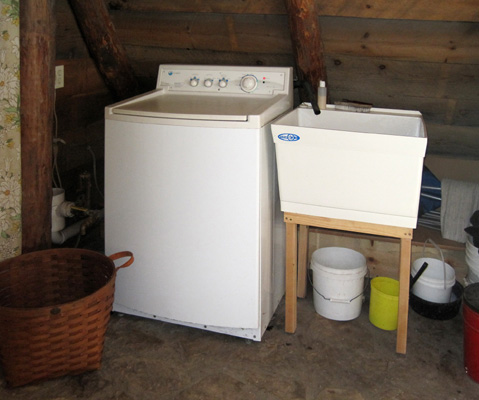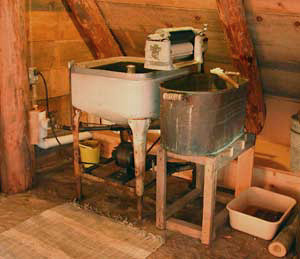We got our old (small, squarish, gray type) Maytag
some forty years ago (about 1979) from a friend in exchange for the use of our van and trailer for a
hauling project. It steadily and reliably took care of our laundry needs for
more than 30 years. As a water saver it can't be beat. You can wash two to four loads in a row in the
wash water, drain, fill with fresh water, then rinse the two to four loads. Or
use the rinse water to wash to next (darker, dirtier) batch(es). It is also
easy to adjust the amount of water to the size of your loads. The flexibility
made up for the bit of longer time it takes to run the laundry through the
wringer (which I still find kind of fun).
When we lived in the cabin it resided on the porch. We ran it with a gasoline engine Steve
set up just outside the porch. A proper sized hole in the wall allowed a long v-belt to
connect washer to engine. It was a nice setup, though we had to haul laundry to town in
the depth of winter, when it got too cold on the unheated porch.
When we moved to the house in 1985 it found its place in the much better insulated porch/entryway, and
was run off a 12 volt
motor made from a truck generator. Since it ran directly off of our 12 volt battery system,
powered by solar panels, the speed of the washer depended on the voltage of our batteries.
So I washed when it was sunny and the batteries charging. Which, while rather
quirky, fit in well since our
dryer is the sun. In the winter I ran a clothesline inside the house (still do), and since we heat
with wood we much appreciate the added humidity from the drying clothes.
After much experience in replacing buttons popped off by the wringer, I came up with a technique of grabbing shirts
by the shoulders and folding the buttonhole side of the front over the buttons before
running, flat, through the wringer, keeping an eye as the cuffs went through to make sure
those buttons also run through flat (easier done than said).
The destruction of zippers on jeans took me longer to resolve, unfortunately. But after
living with pinned up zippers for too long, I finally came up with a simple solution: zip
up and button/snap the pants (and anything else that has a zipper) before washing, then run through the wringer flat, waistband
first, folding over one edge on the large sizes. The wearers of jeans in our family are
much happier now that the zippers stay zipped without pins.
p.s. It's 2009 now and the washer is still running fine. But now, thanks to a
better and larger inverter, it now has a 120v motor and I don't have to wait for
a sunny day to do laundry, though I often do.
If you want to use your graywater from the washer for watering greenhouse or
outside plants, be sure to use a non-sodium based, no boron laundry cleaner,
ideally one made for that use.
2019 - Change is inevitable! And keeps life going. About six years ago friends
who had a state of the art, top load horizontal-axis clothes washer, made in the
USA, Staber washing machine decided to forgo settled life and took to the road
with their four children in a large motor home to experience a different way of
living (which has turned out very well). Material possessions were sorted out
with only the most important making the move to their new mobile life. One of
those items left behind was their Staber, which they really liked but it just
didn't fit in. So they generously passed it on to us.
At the time we had been looking at front loading options to replace the old
Maytag. I had decided it was time to upgrade. But we had several criteria that
made it difficult to find an appropriate washer:
(1) low water pressure (our water is gravity fed from the storage tank up by the
windmill, about a 25 foot drop; enough for our needs but not for most washers);
(2) the need to conserve water in the winter since we can only pump water when
it is above freezing, and it is windy. Some winters the days that this happens
are few and far between, so the water in the 1200 gal tank has to last until
warmer weather. I was used to having and using the 'washtub system', where I
could run rinse water into a tub to be used for washing the next load. It just
made sense and I wasn't happy with the 'modern' alternative of starting each
load with fresh water.
(3) our battery-inverter power system; we weren't sure on many modern appliances
how they would run on this system; and
(4) power consumption. Days are short and cloudy in the winter. Our PV system
has grown but no matter how big it is the panels still need sun to produce power
into the batteries to run whatever we want to run on electricity on the
homestead. So any electrical powered appliance needed to fit in and not be an
energy hog.
 We
hadn't had any luck finding a washer to fit our needs. Until we got the Staber. It worked well on all accounts. We set it up, plugged it in, and off it
went. Well, maybe it did take a bit more than that to get it all together,
including adding a washtub, but it went right back to work doing what it was
made to do - doing a very good job of cleaning our laundry, simply and
efficiently. To say I appreciate this appliance, and, of course, our friends who
put it into our lives, is an understatement. I hadn't realized what many
homemakers had found out decades ago - the old wringer washers take up a lot of
your time and attention. Now this may sound funny to those of roughly my
generation (and newer) who grew up with automatic washers but the release from
having to regularly attend to the washer was invigorating! I laughed about it
for some time as I got used to being able to 'load and go'. But I wouldn't be
able to fully appreciate the differences and contrast had I not spent those many
years with the venerable old Maytag. Both old and new fulfilled, and fill, their
nitch in our homestead life with grace that they can be proud of.
We
hadn't had any luck finding a washer to fit our needs. Until we got the Staber. It worked well on all accounts. We set it up, plugged it in, and off it
went. Well, maybe it did take a bit more than that to get it all together,
including adding a washtub, but it went right back to work doing what it was
made to do - doing a very good job of cleaning our laundry, simply and
efficiently. To say I appreciate this appliance, and, of course, our friends who
put it into our lives, is an understatement. I hadn't realized what many
homemakers had found out decades ago - the old wringer washers take up a lot of
your time and attention. Now this may sound funny to those of roughly my
generation (and newer) who grew up with automatic washers but the release from
having to regularly attend to the washer was invigorating! I laughed about it
for some time as I got used to being able to 'load and go'. But I wouldn't be
able to fully appreciate the differences and contrast had I not spent those many
years with the venerable old Maytag. Both old and new fulfilled, and fill, their
nitch in our homestead life with grace that they can be proud of.
* * * * * *
Copyright
© 1999 - 2019 by Susan Robishaw



 We
hadn't had any luck finding a washer to fit our needs. Until we got the Staber. It worked well on all accounts. We set it up, plugged it in, and off it
went. Well, maybe it did take a bit more than that to get it all together,
including adding a washtub, but it went right back to work doing what it was
made to do - doing a very good job of cleaning our laundry, simply and
efficiently. To say I appreciate this appliance, and, of course, our friends who
put it into our lives, is an understatement. I hadn't realized what many
homemakers had found out decades ago - the old wringer washers take up a lot of
your time and attention. Now this may sound funny to those of roughly my
generation (and newer) who grew up with automatic washers but the release from
having to regularly attend to the washer was invigorating! I laughed about it
for some time as I got used to being able to 'load and go'. But I wouldn't be
able to fully appreciate the differences and contrast had I not spent those many
years with the venerable old Maytag. Both old and new fulfilled, and fill, their
nitch in our homestead life with grace that they can be proud of.
We
hadn't had any luck finding a washer to fit our needs. Until we got the Staber. It worked well on all accounts. We set it up, plugged it in, and off it
went. Well, maybe it did take a bit more than that to get it all together,
including adding a washtub, but it went right back to work doing what it was
made to do - doing a very good job of cleaning our laundry, simply and
efficiently. To say I appreciate this appliance, and, of course, our friends who
put it into our lives, is an understatement. I hadn't realized what many
homemakers had found out decades ago - the old wringer washers take up a lot of
your time and attention. Now this may sound funny to those of roughly my
generation (and newer) who grew up with automatic washers but the release from
having to regularly attend to the washer was invigorating! I laughed about it
for some time as I got used to being able to 'load and go'. But I wouldn't be
able to fully appreciate the differences and contrast had I not spent those many
years with the venerable old Maytag. Both old and new fulfilled, and fill, their
nitch in our homestead life with grace that they can be proud of.